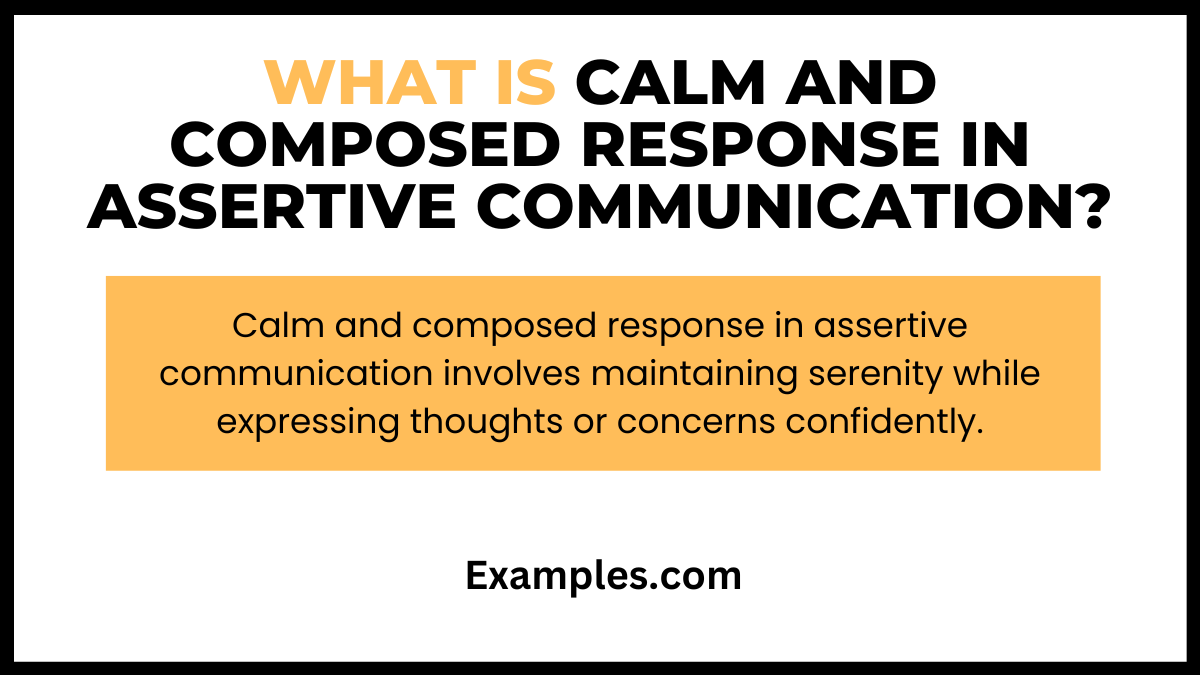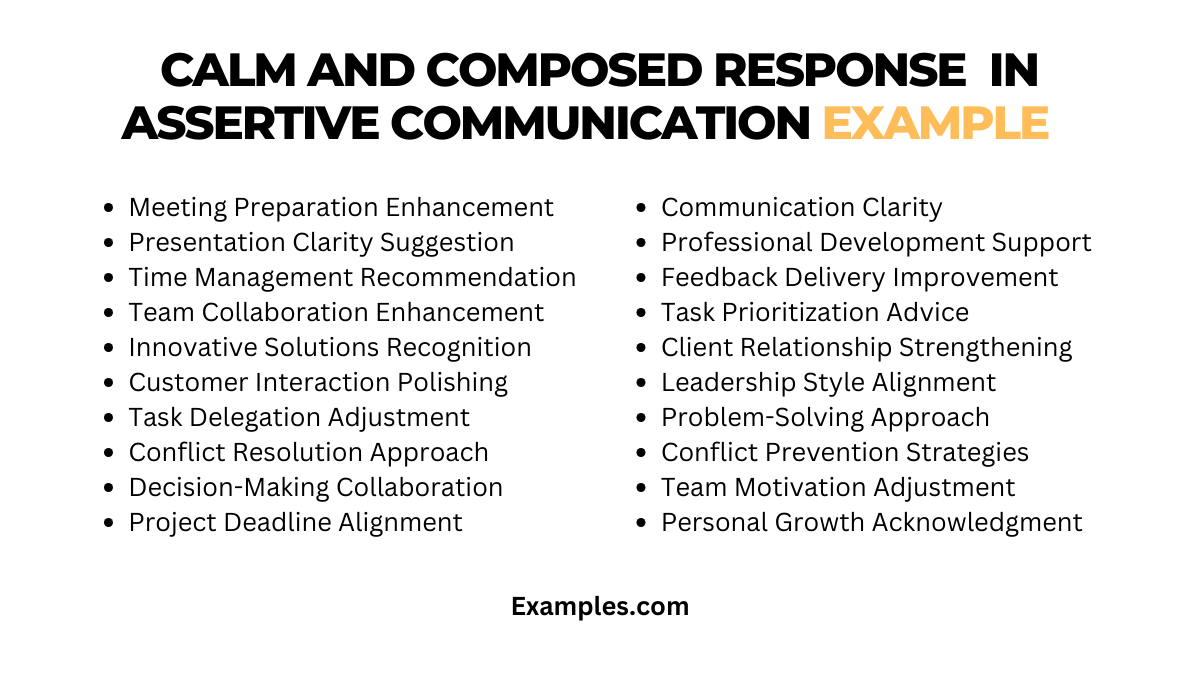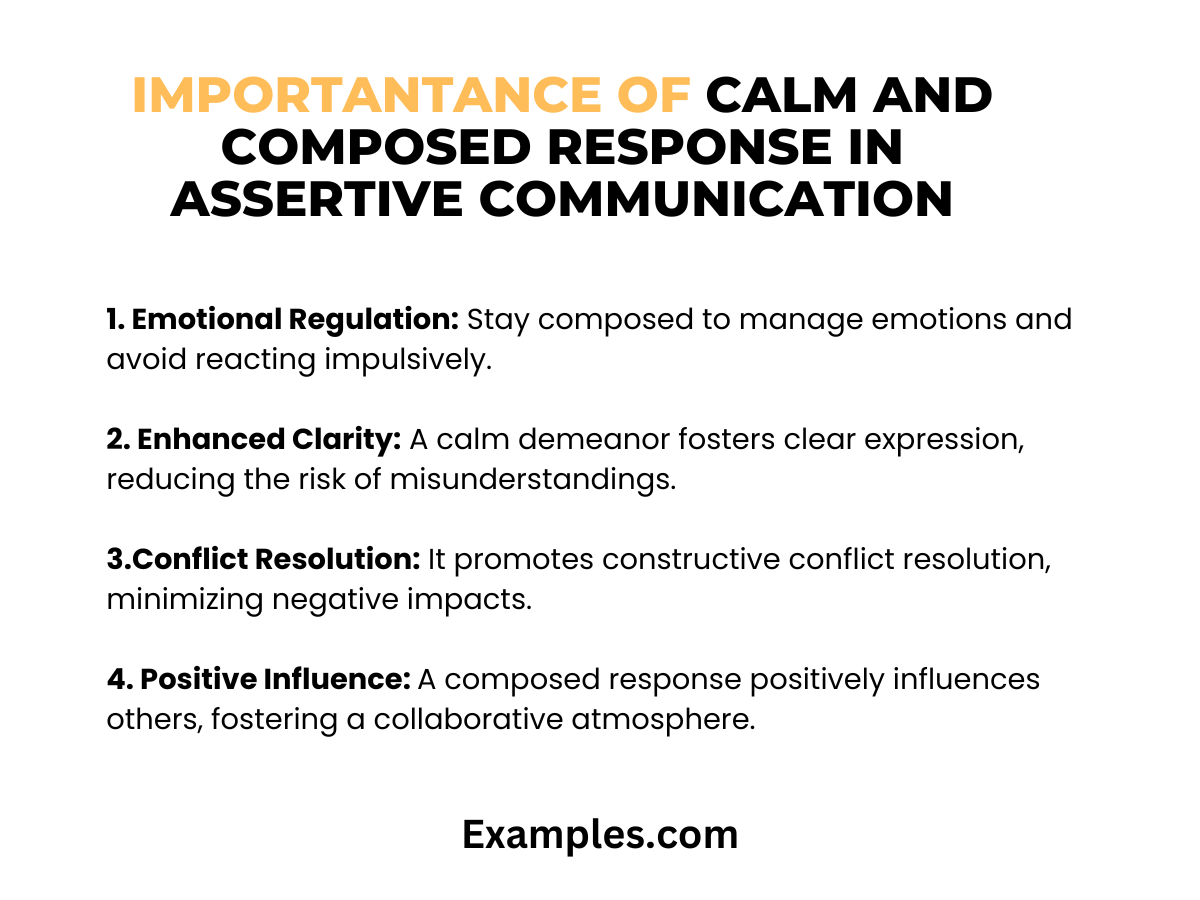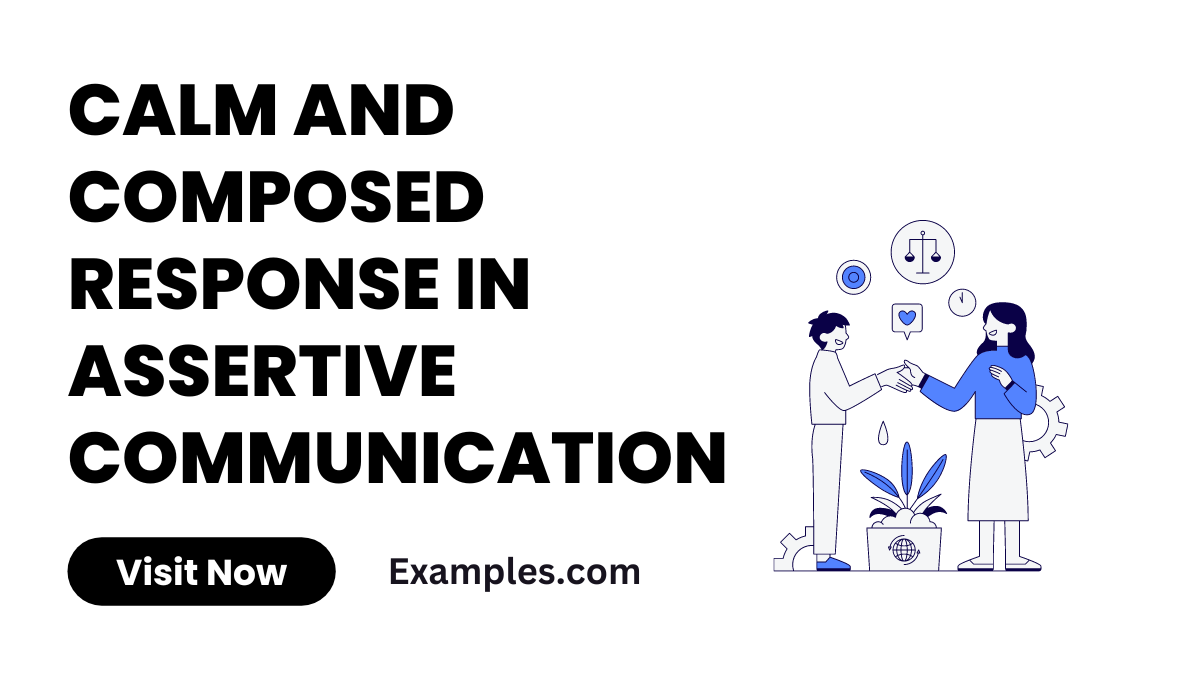19+ Calm And Composed Response In Assertive Communication Examples
Embarking on the journey of assertive communication involves mastering the art of maintaining a calm and composed demeanor even in challenging situations. A calm and composed response is the hallmark of effective communication, fostering understanding and cooperation. This comprehensive guide explores the essence of calm assertiveness, providing practical examples and insightful tips to enhance your communication skills.
What is Calm And Composed Response In Assertive Communication?

A calm and composed response in assertive communication refers to the ability to express oneself confidently, yet with serenity and poise. It involves managing emotions, maintaining composure, and delivering messages assertively without resorting to aggression or passivity. This approach facilitates open and constructive dialogue, contributing to healthier interpersonal relationships and effective communication dynamics.
20 Calm And Composed Response In Assertive Communication Examples

Navigating assertive communication involves mastering the art of maintaining composure in various situations. Explore these 20 examples that showcase the effectiveness of a calm and composed response, fostering healthy dialogue and constructive outcomes. Each example exemplifies the principles of assertiveness, ensuring you can confidently navigate diverse scenarios with poise.
- Meeting Preparation Enhancement: When met with resistance, respond calmly: “I value your input. Let’s ensure our meeting preparation aligns for a more impactful discussion.”
- Presentation Clarity Suggestion: Enhance presentations gracefully: “Your content is appreciated. Let’s ensure clarity with concise slides for better audience engagement.”
- Time Management Recommendation: Encourage efficiency diplomatically: “Your work is commendable. Prioritizing tasks can optimize time management for better results.”
- Team Collaboration Enhancement: Foster teamwork assertively: “Your efforts matter. Let’s consider everyone’s input for collaborative success.”
- Innovative Solutions Recognition: Boost creativity gracefully: “Your ideas are impressive. Let’s explore innovative solutions for enhanced project outcomes.”
- Customer Interaction Polishing: Guide with finesse: “Your communication is valued. Let’s refine customer interactions for a more positive impact.”
- Task Delegation Adjustment: Assertively adjust responsibilities: “Your delegation is appreciated. Let’s ensure a balanced workload for everyone.”
- Conflict Resolution Approach: Encourage constructive resolution: “Your efforts in conflicts matter. Let’s ensure balanced and respectful conflict resolution.”
- Decision-Making Collaboration: Foster inclusive decisions: “Your input is crucial. Collaborative decision-making aligns the team effectively.”
- Project Deadline Alignment: Optimize collective efforts gracefully: “Your commitment is evident. Aligning project deadlines ensures efficiency.”
- Communication Clarity Recommendation: Ensure clearer communication with poise: “Your messages are valuable. Clarity is essential for better understanding.”
- Professional Development Support: Encourage long-term success gracefully: “Your dedication is admirable. Supporting your professional growth is key.”
- Feedback Delivery Improvement: Refine feedback delivery with finesse: “Your insights matter. Let’s enhance feedback delivery for constructive impact.”
- Task Prioritization Advice: Guide with assertiveness: “Your multitasking skills are commendable. Prioritizing tasks ensures optimal efficiency.”
- Client Relationship Strengthening: Affirm client interactions with diplomacy: “Your client rapport is excellent. Let’s strengthen relationships further.”
- Leadership Style Alignment: Align leadership styles diplomatically: “Your leadership is impactful. Aligning our styles fosters better team synergy.”
- Problem-Solving Approach Enhancement: Foster innovation gracefully: “Your approach is appreciated. Exploring alternative problem-solving methods is valuable.”
- Conflict Prevention Strategies: Proactively prevent conflicts: “Your efforts are commendable. Implementing strategies prevents conflicts effectively.”
- Team Motivation Adjustment: Adjust motivational strategies gracefully: “Your efforts are appreciated. Let’s tailor motivation for a more engaged team.”
- Personal Growth Acknowledgment: Acknowledge personal growth diplomatically: “Your commitment is commendable. Supporting your growth journey is essential.”
Calm And Composed Response In Assertive Communication Examples for Students
Navigating assertive communication is vital for students. These examples demonstrate the effectiveness of maintaining composure, fostering healthy dialogues in educational settings. Learn from these scenarios to respond calmly and assertively, ensuring positive interactions with peers and educators.
- Classroom Contribution Acknowledgment: Respond calmly: “Your input enriches our discussions. Let’s ensure everyone’s voice is valued in our learning environment.”
- Feedback Receptivity: Embrace criticism assertively: “Your feedback matters. Let’s discuss it constructively to enhance our academic growth.”
- Group Project Coordination: Assertive teamwork: “Your effort is crucial. Let’s coordinate effectively for a successful group project.”
- Handling Disagreements Diplomatically: Maintain composure: “Your perspective is valued. Let’s address disagreements respectfully for a harmonious learning atmosphere.”
- Time Management Encouragement: Encourage efficiency: “Your dedication is commendable. Prioritize tasks for effective time management and academic success.”
- Handling Academic Pressure: Respond gracefully: “Your concerns are valid. Let’s explore strategies to manage academic pressure and maintain composure.”
- Dealing with Criticism: Navigate criticism assertively: “Your critique is noted. Let’s discuss it calmly to foster mutual understanding and improvement.”
- Balancing Study and Personal Life: Guide assertively: “Your balance is crucial. Let’s ensure effective strategies for managing academic and personal commitments.”
- Seeking Clarification Assertively: Respond confidently: “Your clarification is valued. Let’s ensure clear communication for enhanced understanding in our academic discussions.”
- Participation Encouragement: Encourage engagement: “Your involvement matters. Let’s create an environment where everyone feels comfortable contributing to our learning experience.”
Calm And Composed Response In Assertive Communication Examples for Team
In a team setting, maintaining composure is key for effective communication. Explore these examples showcasing how a calm and composed response fosters collaboration, resolves conflicts, and ensures a positive team dynamic.
- Project Timeline Adjustment: Respond diplomatically: “Your concerns about deadlines are valid. Let’s adjust the project timeline collaboratively for optimal results.”
- Handling Team Conflicts: Navigate conflicts assertively: “Your perspective is important. Let’s address conflicts with composure and find resolutions for a harmonious team environment.”
- Acknowledging Differing Opinions: Maintain composure: “Your opinion is respected. Let’s appreciate diverse viewpoints and find common ground for effective decision-making.”
- Encouraging Team Innovation: Foster creativity gracefully: “Your innovative ideas are appreciated. Let’s explore them further for enhanced project outcomes.”
- Guiding Through Challenges: Respond assertively: “Your challenges are recognized. Let’s face them together with a composed and strategic approach for team success.”
- Handling Task Delegation Concerns: Address concerns diplomatically: “Your concerns about task delegation matter. Let’s revisit roles to ensure everyone’s workload is balanced.”
- Effective Communication Amidst Pressure: Navigate pressure gracefully: “Your concerns about tight deadlines are valid. Let’s communicate effectively to ensure a smooth workflow during challenging times.”
- Encouraging Open Dialogue: Foster transparency assertively: “Your honesty is appreciated. Let’s continue open communication to strengthen our team dynamics.”
- Balancing Workload: Address workload concerns diplomatically: “Your workload matters. Let’s reassess tasks and distribute them effectively for a balanced and productive team.”
- Recognizing Team Achievements: Acknowledge success assertively: “Your contributions are crucial. Let’s celebrate our achievements and continue working collaboratively for more milestones.”
Why is it Important to Maintain a Calm and Composed Response in Assertive Communication?

Maintaining a calm and composed response in assertive communication is crucial for effective interaction. Follow these steps to understand its importance:
- Emotional Regulation: Stay composed to manage emotions and avoid reacting impulsively.
- Enhanced Clarity: A calm demeanor fosters clear expression, reducing the risk of misunderstandings.
- Conflict Resolution: It promotes constructive conflict resolution, minimizing negative impacts.
- Positive Influence: A composed response positively influences others, fostering a collaborative atmosphere.
- Professional Image: Maintaining calmness contributes to a professional image, earning respect and credibility.
How is it Better to Maintain a Calm and Composed Response in Assertive Communication?
Maintaining a calm and composed response in assertive communication is better because it allows individuals to think rationally, choose words carefully, and avoid unnecessary confrontations. A composed demeanor enhances one’s credibility and authority, making it easier to convey messages effectively. It also promotes active listening, demonstrating respect for others’ opinions. This approach contributes to a positive work culture, reduces stress, and helps individuals make well-thought-out decisions.
Tips for Effective Calm and Composed Response in Assertive Communications
- Practice Mindfulness: Engage in mindfulness techniques to stay present and focused during conversations.
- Pause Before Responding: Take a moment to collect thoughts before responding, preventing impulsive reactions.
- Control Nonverbal Cues: Maintain a calm posture, steady eye contact, and controlled gestures to convey composure.
- Active Listening: Pay close attention to others’ perspectives, showing that their opinions are valued.
- Use Empathetic Language: Respond with empathy, acknowledging emotions and expressing understanding.
- Choose Words Wisely: Opt for diplomatic and constructive language, avoiding aggressive or defensive tones.
- Set Boundaries Assertively: Clearly communicate boundaries while remaining respectful and composed.
- Seek Solutions Collaboratively: Focus on finding solutions rather than dwelling on problems, fostering a positive outcome.
- Reflect on Feedback: Embrace constructive criticism with composure, using it as an opportunity for personal growth.
- Mindful Breathing: Incorporate deep breathing exercises to stay calm and composed, especially in challenging situations.
In conclusion, maintaining a calm and composed response in assertive communication is the cornerstone of effective interaction. This guide emphasizes the importance of emotional control, offering examples that showcase the positive impact of such responses. By fostering a serene demeanor, individuals can Navigate Communication challenges with grace, contributing to harmonious relationships and productive collaborations.



